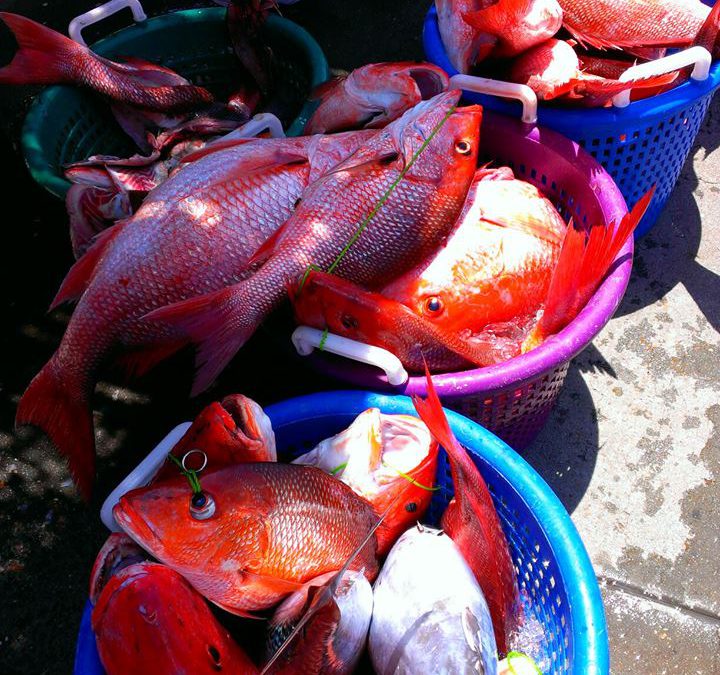
by Rick O'Connor | Mar 20, 2019
I recently had the fortunate opportunity to observe a commercial longline vessel being unloaded at a landing near Perdido Key. 10,000 pounds of fish, mostly grouper and tilefish, were being unloaded for markets in Atlanta, Canada, and locally. When I heard 10,000 pounds two things popped into my head right way…
1) That is a lot of fish
2) It is great to know that fresh local seafood can still be had.
It is a lot of fish, and this concerns some about the future of wild caught seafood. Humans have been harvesting wild caught seafood since the beginning of time, or at least as far back as boats go. What has changed today is better technology and more fishermen on the water. With these issues in mind, you have to either (a) reduce the number of fishermen on the sea, or (b) reduce the number of fish harvested. Though not always popular, this is where fisheries management comes in.
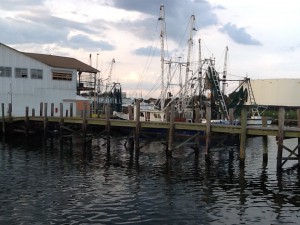
Commercial seafood is a large part of Florida’s economy and culture.
Photo: Rick O’Connor
The basic idea is to allow each species a chance to breed at least once before they are harvested. The Magnuson-Stevens Act, passed in 1996, requires that commercial fisheries within U.S. territorial waters be sustainable – meaning viable into perpetuity. To do this you need to know the life cycles of your target species. At what age do they become sexually mature and begin breeding? The age of a fish can be determined by rings in the otolith (ear bone) and there is a correlation between the number of rings and the length of the fish; hence the length regulations many species have. You need to know at what age they reach maturity, you allow one (sometimes more) years beyond this age allowing them to breed.
The next metric is how many of the mature adults can you allow to be harvested and remain sustainable. This obviously takes a lot of fisheries biology, and there are researchers at the federal, state, and university levels who work on these questions. When you know the answer to some of the biology questions, you can now input this into a computer model and determine what is known as the maximum sustainable yield, or how many fish (or the number of pounds) can be removed and still be sustainable.
Computer models are only as good as the programs that are developed for them. These can be hard to test. Hurricane computer models have become pretty good. Everyone remembers when Michael was approaching the Pensacola area and the modelers were sure it would make an eastward turn; and it eventually did. The thing about hurricane models is that if they are not working well, you know relatively quickly. Hurricane approaches shore – computer predicts where it will go – it makes landfall somewhere else – you correct the model – we get better. With fisheries, and other issues, we do not always get feedback as quickly as this. Stock assessments for selected species have to be made to see how the models are working, and this takes time.
Though it may not be an exact science, fisheries management certainly has helped hold on to some species that would have been harvested out otherwise.
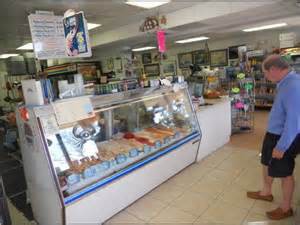
There are about 80 species of commercial seafood products that come from Florida.
Photo: Florida Sea Grant
As far as knowing local seafood is still available, this is good news for many. Checking in with your local seafood markets you can find a variety of species at different times of the year. Some provide information as to which local restaurants they sell to. Many locals, and visitors, are willing to pay a higher price for these sought-after seafood species. It is good to know you can still get them in our area.

by Rick O'Connor | Aug 18, 2017
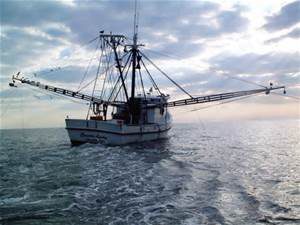
Shrimping in the Gulf of Mexico.
Photo: NOAA
Actually, if you like seafood – it’s all good! However, not everyone does and sometimes when this question is asked they are interested in not how it taste but where the seafood came from.
In recent years, there has been a move across the country to learn more about where their food comes from. Whether that is because they are concerned what the livestock and chickens have been fed, their living conditions, or whether they came outside the United States – more people are asking and it is affecting how they purchase their food. Is it the same for seafood?
In some cases, yes. Several years ago, I ran the marine science program at Washington High School. We were discussing whether, with a growing human population, the ocean could sustain the demand for seafood. Would we need to focus our production on aquaculture? We decided to survey locals to see whether (a) they liked seafood, and (b) if so, would it matter whether the product came from the ocean or a farm. Over a 10-year period, we found that (a) the percentage of locals who did not like seafood increased. (b) Those who did like seafood did not have strong feelings whether it was from a farm or from the sea. Curious as to why those who did not like seafood felt that way, we followed up with those questions and found it was not as much a concern with seafood safety in that they just did not like the taste of it. Of course, this was a high school science project and not a formal science investigation, but they did a good job with it and the results were interesting.
That was almost 20 years ago, do people feel the same? According to Dr. George Baker (Florida Sea Grant), yes… things are about the same. If they can get access to wild harvested seafood at a good price, they will buy. If it is not available, or to expensive, they will, purchase farm raised. Moreover, more people do not like seafood.
What about the local issue? In California, there is a program that allows you to find out which boat captain caught your fish. In Florida, there are studies going on to determine what type of filet you are actually buying. As with produce and livestock, people seem to be interested in where their seafood comes from – and for many, if effects where and how they buy seafood.

Commercial seafood in Pensacola has a long history.
Photo: Rick O’Connor
So what is local?
Well, we call any seafood product harvested or cultured within 250 miles local. For Pensacola, that would include Alabama, Mississippi, and eastern Louisiana. We know that between 80-90% of the seafood you currently purchase is imported from both commercial fishing and aquaculture overseas. That said, local seafood is still here and available.
The commercial fishing in Pensacola goes WAY back. It was one of the first industries to get off the ground shortly after Florida became a U.S. territory. According to Dr. Jack E. Davis, in his book The Gulf; The Making of an American Sea, Cuban fishermen harvested seafood from the Gulf coast of peninsula Florida prior to our becoming a territory. Shortly after becoming a U.S. territory, New England fishermen came to harvest the Gulf, including one by the name of Leonard Destin. Soon a fishing industry was operating in Pensacola. They sold a variety of species but in 1840 they found red snapper – and the boom was on. Shrimp followed but water quality, habitat loss, and overharvesting have plagued the industry over the years. Fishermen did well for a time, then the landings decreased, the fishermen believed the fish had moved, and so the fleet would move. This continued until they have literally moved all over the Gulf of Mexico seeking fish. At this point quotas had to be initiated and regulation has been the norm ever since. Add to this an increase interest in recreational fishing, increasing the number of fishermen, and increased regulation with this sector. Today we can include the introduction of invasive species as another stressor.
All that said, local seafood is still available. Some species have become quite pricey, but they are still available. The Gulf & South Atlantic Fisheries Foundation created a Gulf Coast Seafood Species Chart. This chart indicates when selected species are in peak season for commercial harvest. This chart suggests they are in season year round but there are peak months. It varies from one state to another, but the list below includes Florida and Alabama.
| Species |
Months in Peak Season |
Comments |
| Blue crab |
No peak season |
|
| Blue crab
Soft shell |
Mar – Jun |
|
| Black drum |
No peak season |
|
| Red drum |
No peak season |
Subject to quotas and closures |
| Clams |
All year – FL only |
Clams are now cultured in FL and are available year round |
| Crawfish |
Apr – Jun – LA only |
LA only, but close to us |
| Flounder |
Jul – Aug; Oct-Nov |
Subject to quotas and closures |
| Grouper |
No peak season |
Subject to quotas and closures |
| King mackerel |
Jan – Feb; Jul-Sep; Dec |
Subject to quotas and closures |
| Mahi-Mahi |
May – Jun |
|
| Mullet |
Jan; Sep – Dec |
|
| Oysters |
Jan – Apr; Sep – Dec |
|
| Pompano |
Jan – Apr; |
|
| Sheepshead |
No peak season |
|
| Brown shrimp |
May – Sep |
|
| Pink shrimp |
Jan – Jul |
|
| Rock shrimp |
Jun – Sep |
|
| White shrimp |
May – Nov |
|
| Snapper |
Peak season year round |
Subject to quotas and closures |
| Yellowtail snapper |
Mar – Jun |
|
| Spanish mackerel |
Jan – May; Aug – Sep; Dec |
Subject to quotas and closures |
| Spiny lobster |
Aug – Sep; Oct – Nov |
|
| Spotted seatrout |
No peak season |
Subject to quotas and closures |
| Stone crab |
Oct – Dec |
|
| Swordfish |
Sep – Nov |
|
| Yellowfin tuna |
Jun – Oct |
|
The health benefits from consuming seafood are understood. We certainly think it should be part of your of weekly dinner menu. There are concerns for safety in some seafood products, as in mercury and king mackerel, and we will address that in another article – but the lack of consuming seafood can create health issues as well. We hope you enjoy local Gulf seafood.
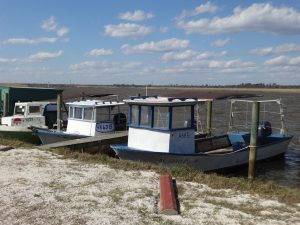
Commercial crab boats docked on Escambia Bay.
Photo: Rick O’Connor
References
Baker, G. 2017. personal communication.
Davis, J.E. 2017. The Gulf; Making of an American Sea. Liveright Publishing. New York NY. Pp. 530.
Gulf & South Atlantic Fisheries Foundation. 2013. Gulf Coast Seafood. www.eatgulfseafood.com
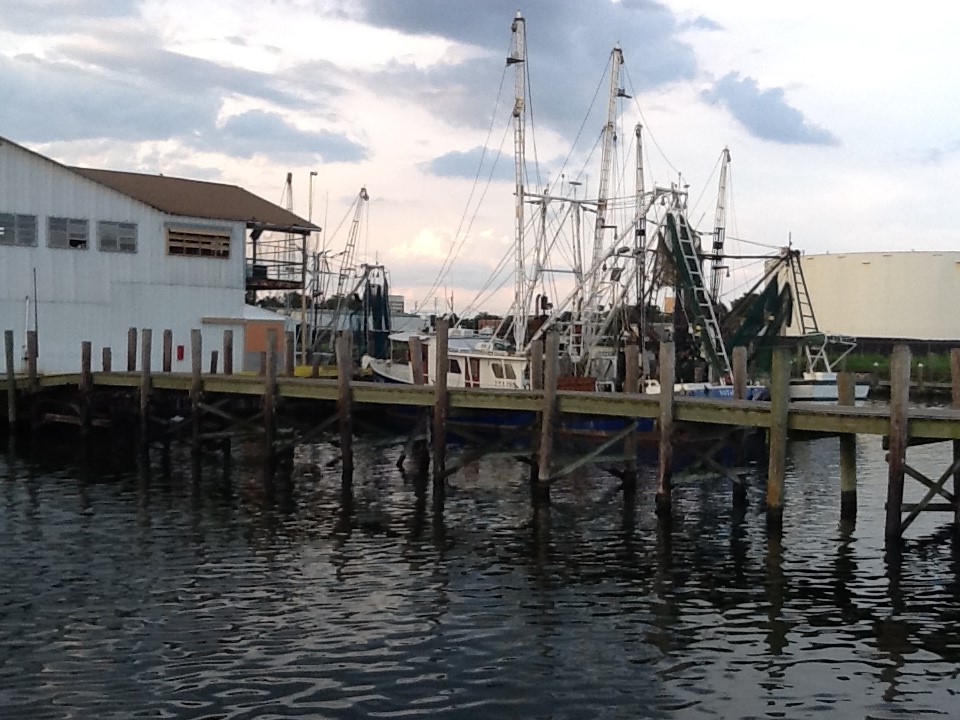
by Rick O'Connor | Jun 17, 2017
ARTICLE WRITTEN BY DR. CHARLES ADAMS, FLORIDA SEA GRANT
The demand for seafood in the US continues to grow. This growth is a function of a number of factors, including the increased awareness of the healthful attributes of many finfish and shellfish products, the increased availability of several key imported, cultured species (shrimp, tilapia, pangasius), and more convenient packaging for home consumption, to name just a few. In terms of wild-caught seafood, effective management at the state and federal level helps ensure the sustainable harvest of traditionally important species, such as reef fish, scallops, flounders, mackerels, and crab.
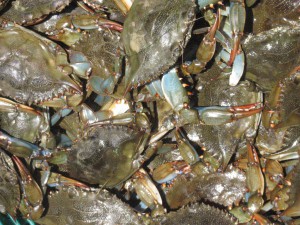
The famous blue crab.
Photo: FWC
According to the latest data from the National Marine Fisheries Service (NMFS), the US domestic fisheries fleet landed about 7.8 billion pounds of edible seafood products, valued at $5.2 billion. Florida plays an important role in this industry, particularly within the Gulf and South Atlantic region. Approximately $250 million worth of seafood is landed by the commercial harvesters in Florida on an annual basis, with some species being landed in Florida, and virtually nowhere else … including pink shrimp, spiny lobster, grouper and stone crab. But wild harvest is not the only source of finfish and shellfish products.
The commercial aquaculture industry is also growing, as the demand for species grown within controlled systems (such as catfish, oysters, striped bass, crawfish, and salmon) continues to increase. The latest NMFS data indicates that the commercial aquaculture industry in the US harvests approximately $1 billion worth of freshwater and saltwater species annually. The success story for aquacultured food items in Florida is molluscan shellfish, in particular cultured hard clams.
Though our wild seafood stocks are sustainably managed and aquaculture production is increasing, approximately 90% of the seafood consumed in the US is imported. Our domestic harvest and culture of seafood simply cannot keep up with demand. We are eating more and more seafood … with the latest NMFS estimate of annual, per capita seafood consumption being 15.5 lbs (edible meat weight). This is the highest level of per capita consumption since 2010. Even though demand is growing, consumers should be confident that the traditional species from our nation’s wild stocks will be there in the future. In addition, the aquaculture industry will help the seafood industry keep pace with growing demand. The seafood industry will continue to be an important source of incomes, jobs, and tax revenue for our coastal communities. And given the increasing number of cultured species and innovative packaging/preparation methods … now is a great time to be a seafood consumer!!
For more information about the US seafood industry, go to https://www.st.nmfs.noaa.gov/Assets/commercial/fus/fus15/documents/FUS2015%20Fact%20Sheet.pdf.
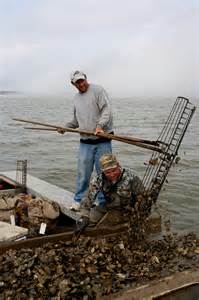
by Rick O'Connor | Nov 18, 2016
I was trying to think of a topic that could connect Thanksgiving and our marine environment. Like many others, when I think of Thanksgiving images of Pilgrims and native Americans come to mind. There is the turkey – and I wrote about “turkey fish” (another name for lionfish) last year. So I continued to think. One thing I do know about the native Americans who lived in this area, they liked oysters. We find middens (piles of oyster shell) in many places around the Gulf coast. These were discard piles from their consumption of the animal. Lots of these indicate, at least to me, that they enjoyed them… and we do also. Oysters are a part of Gulf coast culture and many have them with their Thanksgiving meal.
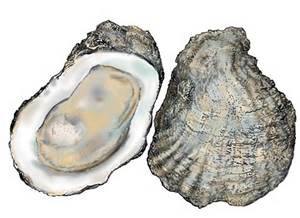
Oysters are one of the more popular shellfish along the panhandle.
Photo: FreshFromFlorida
Oysters are animals – meaning they lack cell walls and must consume their energy. The food of choice is plankton, sounds good doesn’t it! They possess two tubes called siphons which basically filter seawater. One brings water in, the other expels it. As the water enters their body they filter it for food and oxygen. As it leaves they expel waste and carbon dioxide. At times sand is sucked in and becomes lodged – they cannot expel. This “irritant” is covered by a material called nacre and becomes a pearl. Most are not round nor pretty but occasionally there are nice ones… Pacific oysters make better pearls. Amazingly a single oyster can filter up to 20 gallons of water in a day during the warmer months.
They are invertebrates and belong to the phylum Mollusca – meaning they have a soft body. Many invertebrates have a soft body, but what makes mollusks different is that they have bilateral symmetry (a head and tail end), a coleomic cavity (which allows organ development and increased size), and unique to them is a tissue called a mantle (which can secrete a calcium carbonate shell – and most mollusks do this).
Oysters are in the class Bivalvia – meaning they have two shells connected by a hinge at a point called the umbo. Other bivalves include the clams, scallops, and mussels. All of these are popular seafood products. Oysters differ from other bivalves in that they are cemented to a structure and cannot move around (sessile). Many mussels are sessile also but oysters differ in that they use calcium carbonate to literally cement themselves to the substrate, where mussels use a series of threads to do this. Cementing to the substrate means that they are picky about their habitat – it needs to have a hard substrate, sand will not do. We all know this. Place a piling, clay pot, board, or boat in the water… and oysters find it. Typically, they will attach to each other and form small clumps of oysters. These clumps form larger structures we call oyster reefs (or oyster bars) and this is what the commercial oysterman is looking for – and the recreational boater is trying to avoid!
So how do these oysters, who are sessile, find these habitats? Well, when it is time to reproduce oysters (which are hermaphroditic) release their gametes into the water. The sperm and egg that find each other form a planktonic larva called veliger. To increase the chance of finding each other the oysters release their gametes at the same time – a mass spawn. There are a variety of factors that trigger this but water temperature seems to be an important one. The veliger drift in the currents, developing into juveniles, and then settling out as small oysters called spat. If the currents have brought them to a good location, the spat settle on a hard substrate and the next generation begins. If not, they die. So literally millions of fertilized veliger are produced from individual adults. In many cases the suitable substrate are other oysters.
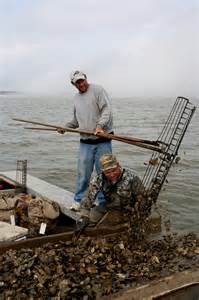
An oysterman uses his 11 foot long tongs to collect oysters from the bottom of Apalachicola Bay
Photo: Sea Grant
Today oysters seem to be in trouble. Large bars have disappeared due to dredging and over harvesting. Hurricanes certainly do damage to some and poor water quality alters their growth and development. Recently problems in Apalachicola include the lack of river water reaching the Gulf. The higher salinities created by the reduction of river flow have increased the number of oyster predators (starfish and snails) as well as diseases. All of that said, they are still a popular seafood item and enjoyed by many during the holidays. The cooler months mean less bacteria in the water and fewer problems consuming them raw. Cooked oysters have few problems… period.
I hope all have a Happy Thanksgiving and if you have not tried oyster dressing, maybe this year could be the year.
Happy Holidays.

by Rick O'Connor | Oct 7, 2016
It’s October and it feels great outside. Time to fire up the grill and enjoy football with your favorite local seafood. So what’s in peak season this month?
Clams – cultured Cedar Key clams are always in season and can be purchased at some local markets.
Oysters – they like the cooler months, there are a lot of ways to prepare them but we recommend cooking them
White Shrimp – other varieties of shrimp are not in peak season at this time but still available
Spiny Lobster – the Florida (Spiny) lobster is still in peak season but more available in south Florida
Stone Crab – we are JUST entering peak season for these guys, but like lobster – they are more common in south Florida.
Flounder – a local favorite this time of year – we are in peak of peak season – enjoy.
Mullet – This is a local favorite with those along the Florida panhandle.
Snapper – these are in peak season year round, but harvesting regulations reduce their abundance at the markets – so you will need to check.
Yellowfin Tuna – these have been in peak season for most of the summer; we are on the down side of it.

The Striped Mullet.
Image: LSU Extension
SPECIES OF THE MONTH…. MULLET
This is one of those – “either you love them or you hate them” fish. It is not news that these are not a popular food fish in much of the Gulf region. In some locations that have an oily/muddy taste that does not appeal to many. In those areas the fish is still abundant but is used as bait. They are an oily fish and are preferred fried or smoked when fresh. Mullet that sit too long develop a strong fishy taste. Mullet roe has its fans… and its enemies. Andrew Zimmern (Bizarre Foods) – did not care for them. They were very popular in the Orient for a period of time, and the local mullet population suffered for it, but that fad has waned.
We actually have 3 species found in the northern Gulf. There are two that frequent the estuaries – the white and the striped mullet. As the name implies, striped mullet does have body stripes as adults. They grow a little larger than the whites and are the one of choice for eating. At times though, the stripes on the striped mullet are hard to see. What then?… well – the white mullet has 9 soft rays on their anal fin, the striped have 8… have fun counting those. Another way is to look at the operculum (the bony plate covering the gills). On FRESH mullet, the white will have a gold spot here that is missing on the striped. The iris of the white mullet has a gold stripe that runs vertically… on the striped mullet the entire iris is gold.
Both species are what we call euryhaline – meaning that can tolerate a wide range of salinities. Striped mullet have been found several hundred miles inland and in Baffin Bay TX (where the salinities can reach 70 ppt). The white mullet prefer saltier habitats and do not frequent the upper estuaries and rivers. White mullet gather and spawn in the spring, striped mullet spawn in the fall – both spawn offshore on the continental shelf.
If you have not tried fried mullet, or smoked mullet dip, give a chance and see what you think. As always – enjoy our local seafood.













